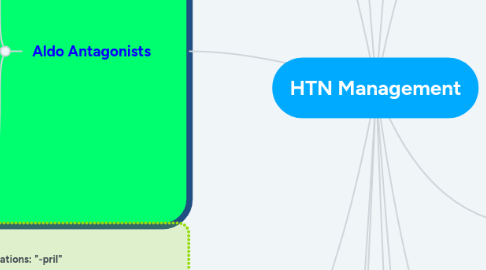
1. K Sparing Diuretics
1.1. Side effects
1.1.1. Hyperkalemia
1.1.2. GI disturbances
1.2. Mediations
1.2.1. Triamterene (Dyrenium)
1.2.2. Amiloride (Midamor)
1.3. Cont.
1.3.1. Anuria & sulfa allergy
1.3.2. Severe hepatic disease
1.3.3. Hyperkalemia
2. Aldo Antagonists
2.1. Medications
2.1.1. Spironolactone (Aldactone)
2.1.2. Eplerenone (Inspra)
2.2. Fun facts
2.2.1. 1st line in pts with HF or MI
2.2.2. Useful in pts with resistant HTN
2.2.3. AA population responds well
2.2.4. Contraindication: Anuria
2.3. Side effects
2.3.1. Hyperkalemia
2.3.2. Gynecomastia
2.3.3. Amenorrhea/menstrual abnormalities & impotence
3. ACEi
3.1. Medications: "-pril"
3.2. Fun Facts
3.2.1. 1st line with indications: Stroke, diabetes w/ proteinuria, HF, CAD, CKD, post MI
3.2.2. All daily dosing EXCEPT captopril
3.2.3. More effective if used with diuretic
3.2.4. 1st line for AA pop if compelling indications exist
3.3. Side Effects
3.3.1. Dry-non productive cough
3.3.1.1. Alternative: D/C and initiate ARB
3.3.2. Angioedema {contr.}
3.3.3. Hyperkalemia
3.3.3.1. Symptoms: nausea, fatigue, muscle weakness, palpitations
3.3.4. Acute RF
3.3.5. Terotogenic
3.3.6. Transient increase in SCr after initiation
4. BB & Mixed alpha/beta blocker
4.1. Beta 1 selective
4.1.1. Atenolol (Teneormin)
4.1.1.1. Not beneficial with BP lowering
4.1.2. Metoprolol Tart (Lopressor)
4.1.3. Metoprolol Succ (Toprol XL)
4.1.4. Nebivolol (Bystolic)
4.1.5. Bisoprolol, Betaxolol
4.2. Non-selective
4.2.1. Propranolol/ER
4.3. Mixed Alpha BB
4.3.1. Carvedilol (Coreg)
4.3.2. Labetalol
4.4. Indications
4.4.1. Post MI
4.4.2. HF
4.4.3. High coronary disease risk
4.5. Side effects
4.5.1. Orthostatic hypotension
4.5.2. bradycardia
4.5.3. Exercise intolerance & fatigue
4.5.4. AV block
4.5.5. Impaired peripheral blood flow
4.5.6. bronchospasms
4.5.6.1. Warning pts w/ asthma or bronchospastic disease. Beta 1 selective preferred
4.5.7. impotence, decreased libido
4.5.8. Mask signs/symptoms of hypoglycemia
4.6. Contr.
4.6.1. Abrupt withdrawl: BB tapered over 1-2 weeks to avoid acute tachycardia, HTN, ischemia
4.6.2. Not with pts bradycardia (<45)
5. Alpha 1 blockers
5.1. Medications
5.1.1. Doxazosin (Cardura)
5.1.2. Prazosin
5.1.3. Terazosin (Hytrin)
5.2. Fun Facts
5.2.1. Treatment of benign prostatic hypertrophy (BPH)
5.2.2. HTN in pts who have failure to achieve control with other medications
5.3. Side effects
5.3.1. Orthostatic hypotension/syncope
5.3.2. Peripheral edema (Na & H2O retention)
5.3.3. Reflex tachycardia
5.3.4. Sexual dysfunction (decreased libido, ejaculatory volume reductions)
6. HTN Urgency/ER
6.1. Urgency (>180 or >120 w/o evidence of end organ damage)
6.1.1. reduce BP to goal <160/100 over 24-48 hours
6.1.2. short acting agents often initially (captopril, labetalol, clonidine)
6.1.3. Adjust maintenance therapy: add new anti-HTN or titrate dose of an existing medication
6.2. Emergency (>180 or >120 with evidence of end organ damage
6.2.1. Pt treated in inpatient setting for continuous BP monitoring & target organ damage and parenteral administration of medicaitons
6.2.2. Pts best managed with short-acting rapidly titratable IV medications
6.2.2.1. Reduce by DBP by no more than 25% within first hour
6.2.2.2. Once stable, reduce BP to 160/100-110 over 2-6 hours
6.2.2.2.1. Once stable, decrease to normal BP over the next 24-48 hours
6.2.2.3. Once BP stable with IV agents & end organ damage stopped, oral agents can be initiated
7. CCB
7.1. Medications
7.1.1. DHP
7.1.1.1. Amlodipine (Norvasc)
7.1.1.1.1. Initial 5mg-up to 10mg
7.1.1.2. Nifedipine (Procardia)
7.1.1.3. Felodipine (Plendil)
7.1.1.4. Nisoldipine (Sular)
7.1.1.5. Side effects
7.1.1.5.1. Reflex Tachycardia
7.1.1.5.2. Peripheral edema (ankle swelling)
7.1.1.5.3. Flushing
7.1.1.5.4. Headache
7.1.1.5.5. Gingival hyperplasia
7.1.2. Non-DHP
7.1.2.1. Diltiazem (Cardizem)
7.1.2.2. Verapamil (Covera/Verelan)
7.1.2.2.1. Not used for HTN!!
7.1.2.3. Side effects
7.1.2.3.1. Brady cardia
7.1.2.3.2. Peripheral edema
7.1.2.3.3. Conduction defects (AV block)
7.1.2.3.4. Gingival hyperplasia
7.1.2.3.5. Constipation
7.1.3. Contr.
7.1.3.1. Avoid use with BB (increased risk of bradycardia & heart block)
7.1.4. Non DHP contr in pts with sinus syndrome, 2nd/3rd degree AV block, or HR <45bpm
7.2. Fun Facts
7.2.1. 1st line for additional BP lowering who don't reach goal w/ thiazide, ACE, ARB
7.2.2. 1st line for: Diabetes, AA pop, high coronary disease risk
8. Loop Diuretics
8.1. Medications
8.1.1. Furosemide (Lasix)
8.1.2. Bumetanide (Bumex)
8.1.3. Torsemide (Demadex)
8.1.4. Ethacrynic Acid
8.2. Not used in HTN {won't sustain BP decrease}
8.3. Typically used in CHF {fluid overload}
9. Thiazide Diuretics
9.1. Medications
9.1.1. HCTZ (Microzide/hydrodiuril)
9.1.2. Chlorthalidone (Hygroton)
9.1.3. Metolazone (Zaroxolyn)
9.1.4. Indapamide (Lozol)
9.2. Fun facts
9.2.1. 1st line for HTN
9.2.2. Inexpensive
9.2.3. Should be given in AM {nocturnal diuresis}
9.2.4. Very effective when used in combination with other medications
9.3. Side Effects
9.3.1. Hypo- kalemia, natremia, calcemia
9.3.2. Hyperuricemia: may cause acute gout attack in pt with history of gout
9.3.3. Hyperglycemia: diabetic pts need to closely monitor blood sugars
9.4. Cont.
9.4.1. Anuria, Sulfa allergy (monitor), CrCl <30
9.5. Pearls
9.5.1. Max 25mg HTCZ & chlorthalidone in HTN
9.5.2. Chlorthalidone preferred, more potent & more effective at lowering BP
9.5.3. Effective when used with other medications
9.5.4. Increased effectiveness in AA population
10. Renin Inhibitor
10.1. Medication: Aliskiren (Tekturna)
10.2. Fun Facts
10.2.1. Brand only {expensive}
10.2.2. Cont. in diabetics also taking ACE or ARB
10.2.3. Warning against use GFR <60
11. ARBs
11.1. Medications: "-sartan"
11.2. 1st line: diabetes w/ proteinuria, CKD, HF
11.3. Fun Facts
11.3.1. Considered after pt has failed use of ACEi
11.4. SE
11.4.1. Dry & non productive cough
11.4.2. Angioedema
11.4.3. Hyperkalemia
11.4.4. Acute RF
11.4.4.1. Contain renal protective effects
11.4.5. Terotogenic
11.4.6. Transient increase in SCr after initiation
12. Alpha 2 agonists
12.1. Medications
12.1.1. Clonidine (Catepres)
12.1.1.1. MUST BE TAPERED
12.1.2. Methyldopa
12.1.3. Guanfacine
12.2. Fun facts
12.2.1. LAST LINE in HTN
12.2.2. Avoid in elder pts {CNS & orthostatic}
12.3. Side effects
12.3.1. Bradycardia
12.3.2. Orthostatic hypotension
12.3.3. Xerostomia, constipation
12.3.4. CNS side effects (sedation)
